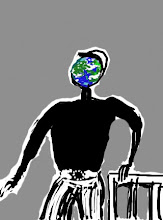I read Kim Moore's lovely short poem ‘The Rabbit and the Moon’ in a recent
TLS (29th Jan 2010):
Let me tell you the story of a high, lonely place
where sight and sound carry with the pylon
that gives its shadow to the hill, and the farm
many fields away, and the long straight road.
Bold to evoke a pylon, that artefact of the discredited non-Audenesque 1930s school of poetry—but so evocatively done, too: not the pylon itself, but the shadow it generously gives away, and the bright sunshine (or moonshine) that is implied in the image. The scene set very neatly.
A bird calls kehaar, kehaar to the moon
and trains are falling, falling into the night.
The black rabbit waits outside the caravan
and come morning, the booted feet of gulls
‘Falling’ for the sound of trains in the night is very good; and if booted is a little too hobnailed to describe gulls’-feet, I very much like the way the birdcall, with its Arabic air, is the name (Kehaar) of the seagull in
Watership Down. The poem wants us to think of that famous rabbit tale, and to situate its plangently, deftly evoked English hill, and pylon-shadow, in that resonant world.
will be telling us to leave, but if we stay,
the dogs will lie like rugs at our feet.
Somewhere there are other rabbits, and a river
to sail away on. Somewhere there’s a boat.
Is there, though? The clues disposed through the stanzas (‘tell a story’, ‘gull’, ‘lie’) point to the principle of fictiveness at the heart of this poem, as of all poetry. A caravan is like a boat, but not very. The rabbit is actually black—there aren’t any black rabbits wild in Britain—it only looks that way in the night. The moon is a high and lonely place, but no sound carries there.

No comments:
Post a Comment